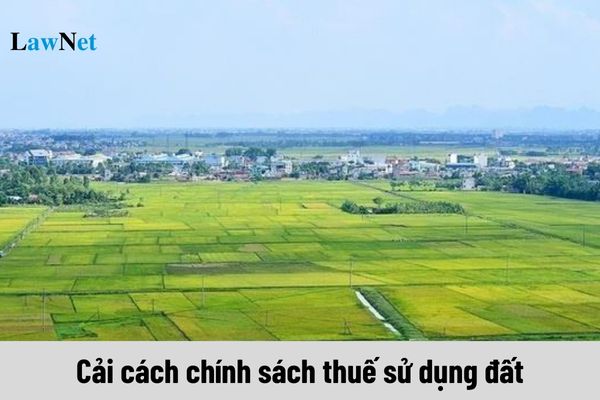What are the solutions for agricultural land use tax and non-agricultural land use tax policy reform according to the tax reform strategy until 2030 in Vietnam?
What are the solutions for agricultural land use tax and non-agricultural land use tax policy reform according to the tax reform strategy until 2030 in Vietnam?
According to Point g, Clause 1, Section 3, Article 1 of Decision 508/QD-TTg of 2022, the solutions for agricultural land use tax and non-agricultural land use tax policy reform according to the tax reform strategy until 2030 in Vietnam are specified as follows:
- Continue to grant exemption from agricultural land use tax until the end of 2025 to contribute to the implementation of the Party and State's guidelines on agricultural and rural development.
- Complete general review reports on implementation of non-agricultural land use tax policies.
- On such basis, study and complete these tax policies with a view to levying more taxes on land and home in order to encourage the effective use of real property, contributing to limiting the speculation in real estate, and ensuring a reasonable and stable source of revenues remitted into the state budget and conformity with Vietnam's socio-economic condition and international practices.
- Concurrently, develop tax policies to ensure that they are simple, easy to understand, easy to be used for identifying items subject to property tax, tax amounts payable, and in line with provisions of land law and regulations of relevant law;

What are the solutions for agricultural land use tax and non-agricultural land use tax policy reform according to the tax reform strategy until 2030 in Vietnam? (Image from the Internet)
What types of land are subject to agricultural land use tax in Vietnam?
According to Article 2 of the Agricultural Land Use Tax Law 1993 and Article 2 of Decree 74-CP of 1993, the types of land subject to agricultural land use tax includes:
- Cultivated land, including Land for annual crops, Land for perennial crops, and grassland.
- Land for annual crops is land for growing crops with a growth period (from planting to harvest) of no more than 365 days like rice, corn, vegetables, peanuts, etc., or crops that are harvested a few times without undergoing a basic construction period like sugarcane, banana, sedge, jute, citronella, pineapple.
- Land for perennial crops is land for growing crops with a growth cycle of more than 365 days, planted once but harvested over many years and undergoing a basic construction period before harvest, such as rubber, tea, coffee, orange, mandarin, longan, palm, coconut.
- Grassland allocated for growing grass for livestock.
- Land with water surface used for aquaculture is land that has been allocated for specialized aquaculture or combined aquaculture and cultivation, but fundamentally is not used for other purposes.
- Forestry land is land that has been allocated for forest planting and has been handed over to institutions, and individuals for management, care, and exploitation, excluding bare hills and mountains.
If the land user does not use types of land subject to tax stated in this article, the land user still must pay tax according to the Agricultural Land Use Tax Law.
What does agricultural land in Vietnam include?
Under Article 9 of the Land Law 2024, the provisions are as follows:
Land classification
1. Depending on use purposes, land is classified into three main categories: agricultural land, non-agricultural land and vacant land.
2. The category of agricultural land is classified into the following sub-categories/types:
a) Land for annual production, including land for rice cultivation/ paddy cultivation and another annual crop land;
b) Perennial crop land;
c) Forestry land, including dedicated forest land, protective forest land, and production forest land;
d) Land for aquaculture;
dd) Land for intensive farming;
e) Land for salt production;
g) Other agricultural land.
3. The category of non-agricultural land includes:
a) Homestead land including rural homestead land and urban homestead land;
b) Land for construction of head offices/offices;
c) Land used for national defense and security purposes (hereinafter referred to “national defense land and security land”);
d) Land for construction of public works, including land for construction of cultural facilities, social facilities, health facilities, education and training institutes, physical training and sports centers, science and technology facilities, environmental facilities, hydro-meteorological centers, diplomacy centers and other public works or land for construction of head offices/offices of other public service providers;
dd) Land used for non-agricultural business and production purposes, including land for industrial parks and industrial clusters; land used for trading or service purposes/commercial land; non-agricultural production establishment land; land used for mineral-related activities;
e) Land used in the public interest, including land used for transport; land used for irrigation; land for water supply and drainage works; land for natural disaster prevention and management works; land with historical-cultural monuments, famous landscape, sights, natural heritage; land for waste treatment works; land for energy and public lighting projects; land for post, telecommunications and information technology infrastructure; land for residential markets and wholesale markets; land for public entertainment, recreation and community activities;
g) Land used for religious exercise/used by religious organizations (religious land); land used by belief organizations (belief land);
h) Land used for cemeteries, funeral service centers and cremation centers; land for ashes storage facilities;
i) Dedicated water-covered land;
k) Other non-agricultural land.
4. The category of vacant land includes unallocated/unleased land for which use purposes have not been determined yet.
5. The Government of Vietnam elaborates land categories in this Article
Agricultural land includes the following types:
- Land for annual production, including land for rice cultivation/ paddy cultivation and another annual crop land;
- Perennial crop land;
- Forestry land, including dedicated forest land, protective forest land, and production forest land;
- Land for aquaculture;
- Land for intensive farming;
- Land for salt production;
- Other agricultural land.
Additionally, based on Article 10 of the Land Law 2024, the determination of land types shall be based on:
- Certificate of LUR, certificate of home ownership and LURs of homestead land, certificate of LURs, ownership of housing and other property affixed to land; or certificate of title;
- Documents on LURs prescribed in Article 137 of this Law in case the certificates mentioned in point a of this clause have not yet been granted;
- Decision on land allocation, land lease or permission for land repurposing issued by a competent regulatory agency in case where the certificates mentioned in point a of this clause have not yet been granted.


- When is the deadline for paying tax, duty payment guarantee and tax deposit in Vietnam?
- Are natural aquatic resources exempt from severance tax in Vietnam?
- Are natural swallow's nests subject to severance tax in Vietnam?
- What are the principles for developing a List of goods to be imported free of duty in Vietnam?
- How long is the CIT period of the first year in Vietnam?
- Shall individuals be entitled to tax refund if their taxed incomes do not reach a tax-liable level in Vietnam?
- What are regulations on responsibilities of income payer regarding PIT refund when being delegated to settle tax in Vietnam?
- Is it necessary to terminate the tax identification number when a business temporarily suspends its operations in Vietnam?
- What is the value-added tax declaration form for 2024 in Vietnam?
- What are forms for declaring corporate income tax in Vietnam?

